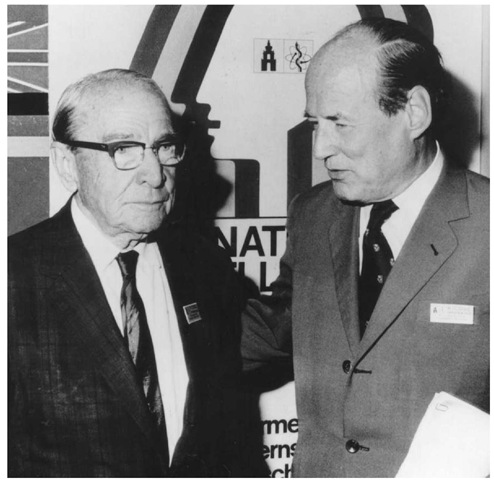Vladimir Zworykin is considered one of the "fathers of television," as his invention of the iconoscope and the kinescope led to the development and commercial distribution of electronic television. He based his system on a theory proposed by Alan Archibald Campbell-Swanton in 1908, though at that time the technology did not exist to realize this theory. Zworykin also directed the laboratory responsible for the invention of the electron microscope, an instrument that allowed for the examination of samples at the atomic level. He also invented the electric eye (used in security systems and with electric door openers) as well as the infrared electron image tube, or night-vision technology.
Vladimir Kosma Zworykin was born on July 30, 1889, in Murom, Russia, near Moscow. His mother was Elaine Zworykin, and his father, Kosma Zworykin, owned and ran a riverboat operation on the Oka River. Zworykin went to the St. Petersburg Institute of Technology, where he studied electrical engineering under Boris Rosing, an early television pioneer who passed on to his student the belief in the superiority of electronic methods of transmitting streams of charged particles with cathode-ray tubes over mechanical transmission methods.
After Zworykin graduated from the institute in 1912, he traveled to Paris to conduct X-ray research under Paul Langevin at the College de France. Upon the outbreak of World War I, he returned home to work for the Russian Marconi Company in St. Petersburg, and then in Moscow. When Russia entered the war, he served in the Russian Army Signal Corps; also during the war, he married Tatiana Vasilieff, with whom he had two children. After the war, Zworykin and his family escaped the chaos of the Bolshevik Revolution and traveled the world until they settled in the United States, where he secured work as a bookkeeper for the financial agent of the Russian embassy.
In 1920, the Westinghouse Corporation hired Zworykin to work in its research laboratories developing radio tubes and photoelectric cells. He also followed up on his earlier work in television, developing the iconoscope, which used an electron beam to detect electrical impulses emitted from photoelectric cells mounted on a mica plate containing an image focused there by a lens. The electron beam scanned top-to-bottom in parallel lines, with the number of lines corresponding to the resolution. He applied for a patent on December 29, 1923, but the U.S. patent office did not grant the iconoscope patent until some 15 years later, in December 1938.
In 1924, Zworykin gained his U.S. citizenship. That same year, he filed a patent for the kinescope, which received and displayed the iconoscope’s transmission. The kinescope consisted of a hard-vacuum cathode-ray tube that focused a steady electron beam on a signal-modulation grid; this device came to be known as the picture tube. He demonstrated his new electronic television system to his superiors at Westinghouse. "I was terribly excited and proud," he remembered. "After a few days I was informed, very politely, that my demonstration had been extremely interesting, but that it might be better if I were to spend my time on something ‘a little more useful.’"
Zworykin persevered, patenting a color television system in 1925 (that was granted in 1928) and earning his Ph.D. from the University of Pittsburgh in 1926 with a dissertation on the improvement of photoelectric cells. In 1929, the Radio Corporation of America (RCA) hired him as associate director of electronic research, in large part to develop television technology for commercial distribution. When asked how much to budget for this project, Zworykin estimated "about $100,000." According to RCA chairman David Sarnoff, "RCA spent $50 million before we ever got a penny back from TV."
After laying the theoretical foundation for electronic television, Zworykin left the development to other RCA engineers. In the meanwhile, he oversaw his research group member Ames Hillier’s invention of the electron microscope, which took advantage of the extremely short wavelength of electron beams to achieve extremely high magnification of a millionfold, enabling scientists to make observations at the atomic level. The scanning electron microscope used an electron beam to scan the specimen and displayed the image by the same theory as electronic television. The first industrial electron microscope appeared in 1941.
Vladimir Zworykin (left) is considered one of the fathers of television for his invention of the iconoscope and the kinescope.
Zworykin spent World War II on the Scientific Advisory Board of the U.S. Air Force, developing radar, aircraft fire-control, and TV guided missiles. After the war, in 1946, RCA promoted him to director of electronic research, and the next year, it elevated him yet again to a vice presidency and a technical consultancy.
Upon his 1954 retirement to emeritus status at RCA, he became director of the Rockefeller Institute for Medical Research (now Rockefeller University), a position he retained until 1962.
Zworykin collected numerous honors and awards for his pioneering work: the 1934 Morris Liebmann Memorial Prize from the Institute of Radio Engineers; the 1952 Edison Medal from the American Institute of Electrical Engineers; the 1965 Faraday Medal from the Institute of Electrical Engineers; and the 1967 U.S. Medal of Science. Throughout his career, he secured more than 120 patents. When asked in 1981 for his opinion of television programming, he replied that it is "awful." Zworykin died the next year, on July 29, 1982, just one day short on his 93rd birthday.

